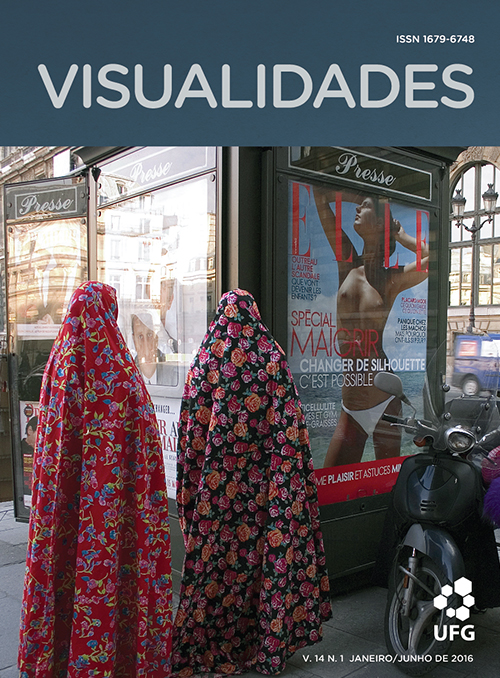The cultural counter-discourse on Lisbon’s slums
DOI:
https://doi.org/10.5216/vis.v14i1.34690Abstract
The urban periphery —slums— of Lisbon will be observed as the space of manifestation of the counter-discourse of contemporaneity with respect to the symbolic and cultural imaginary of Portugal. The music, as a production of the residents of the slums, particularly rap music, and contemporary cinema, as a mean of representation of these places, have contributed to the decentralization of the national imaginary and to the deconstruction of Portugalidade, showing the changes in social and cultural profile of the country in recent decades . To address this issue, we will focus on the critical production of some theorists such as Stuart Hall and Roger Haesbaert which have reflected respectively on the theme of diaspora and the concept of reterritorialization.
Keywords: Counter-discourse, periphery, postmodern space
Downloads
References
BAPTISTA, Tiago. A Invenção do Cinema Português. Lisboa: Tinta da China, 2008.
BAPTISTA, Tiago. Depois do Cinema Português. Cinema em Português. Covilhã, Livros
LabCom, p.520, 2011.
BHABHA, Homi. O Local da Cultura. Belo Horizonte: Editora UFMG, 1998.
CONTADOR, António Concorda. Cultura Juvenil Negra em Portugal. Oeiras: Celta Editora,
COSTA, Rogério. O mito da desterritorialização: do “fim dos territórios” à multiterritorialidade. 1ª ed. Rio de Janeiro : Bertrand Brasil, 2004.
COSTA, Sérgio. Dois Atlânticos. Teoria social, antiracismo, cosmopolitismo. Belo Horizonte: Ed. da UFMG, 2006.
CIPRIANO, Miguel. Identidade e Descentramento em Pedro Costa. Novas e Velhas Tendências no Cinema Português Contemporâneo. Lisboa: Arte e Media. p. 481-484, 2012.
DE SOUZA, Angela Maria. A Caminhada é longa... e o Chão tão liso: o movimento hip hop
em Florianópolis e Lisboa. Florianópolis: UFSC, 2009.
DERRIDA, Jacques. Of Grammatology. Tradução Gayatri Spivak. Baltimore, MD: Johns
Hopkins University Press, 1974.
GILROY, Paul. O Atlântico Negro. Modernidade e dupla consciência, São Paulo, Rio de
Janeiro, 34/Universidade Cândido Mendes – Centro de Estudos AfroAsiáticos, 2001.
HALL, Stuart. A Identidade na Pós.modernidade. Rio de Janeiro:DP&A,2011.
HALL, Stuart. Da diáspora: identidades e mediações culturais. 2ª ed. Belo Horizonte: Ed. da UFMG? Brasília: UNESCO, 2013.
HARVEY, David. The Condition of Postmodernity. Oxford: Blackwell, 1989.
HOBSBAWM, Eric? RANGER. Terence. The Invention of Tradition. Cambridge: Cambridge
University Press, 1983.
NO QUARTO de Vanda. Produção Pedro Costa. Lisboa: Criterion. 2010. CD.
OSSOS. Produção Pedro Costa. Lisboa: Criterion. 2010. CD.
RANCIÈRE, Jacques. O que significa estética. Ymago project. 2011 http://cargocollective.com/ymago/Ranciere-Tutti
SANTIAGO, Silvano. Uma literatura nos Trópicos. São Paulo: Editora Perspectiva, 1971.
SANTOS, Milton. O retorno do território. Observatorio Social de América Latina. Ano 6,
n.16. Buenos Aires : CLACSO, p. 251261, jan./abr. 2005.
SHOHAT, Ella? STAM, Robert. Crítica da imagem eurocêntrica. São Paulo: Cosac Naify, 2006.
JUVENTUDE em Marcha. Produção Pedro Costa. Lisboa: Criterion. 2010. CD.
ZONA J. Produção de Leonel Vieira Lisboa: MGN FILMES. 2010. CD.
Downloads
Published
How to Cite
Issue
Section
License

This work is licensed under a Creative Commons Attribution 4.0 International License .
Authors who publish in this journal agree to the following terms:
a. Authors retain the copyright and grant the journal the right of first publication, with the work simultaneously licensed under the Creative Commons Attribution 4.0 License which allows the sharing of work with acknowledgment of authorship and initial publication in this journal.
b. Authors are authorized to take additional contracts separately, for non-exclusive distribution of the version of the work published in this journal (eg publish in institutional repository or as a book chapter), with acknowledgment of authorship and initial publication in this journal.
c. Authors are allowed to publish and distribute their work online (eg in institutional repositories or on their personal page) after the initial publication in this journal, as this can generate productive changes, as well as increase the impact and citation of the published work ( See The Effect of Free Access).
Every effort has been made to identify and credit the rights holders of the published images. If you have rights to any of these images and have not been correctly identified, please contact the Visuals magazine and we will publish the correction in one of the next issues.






